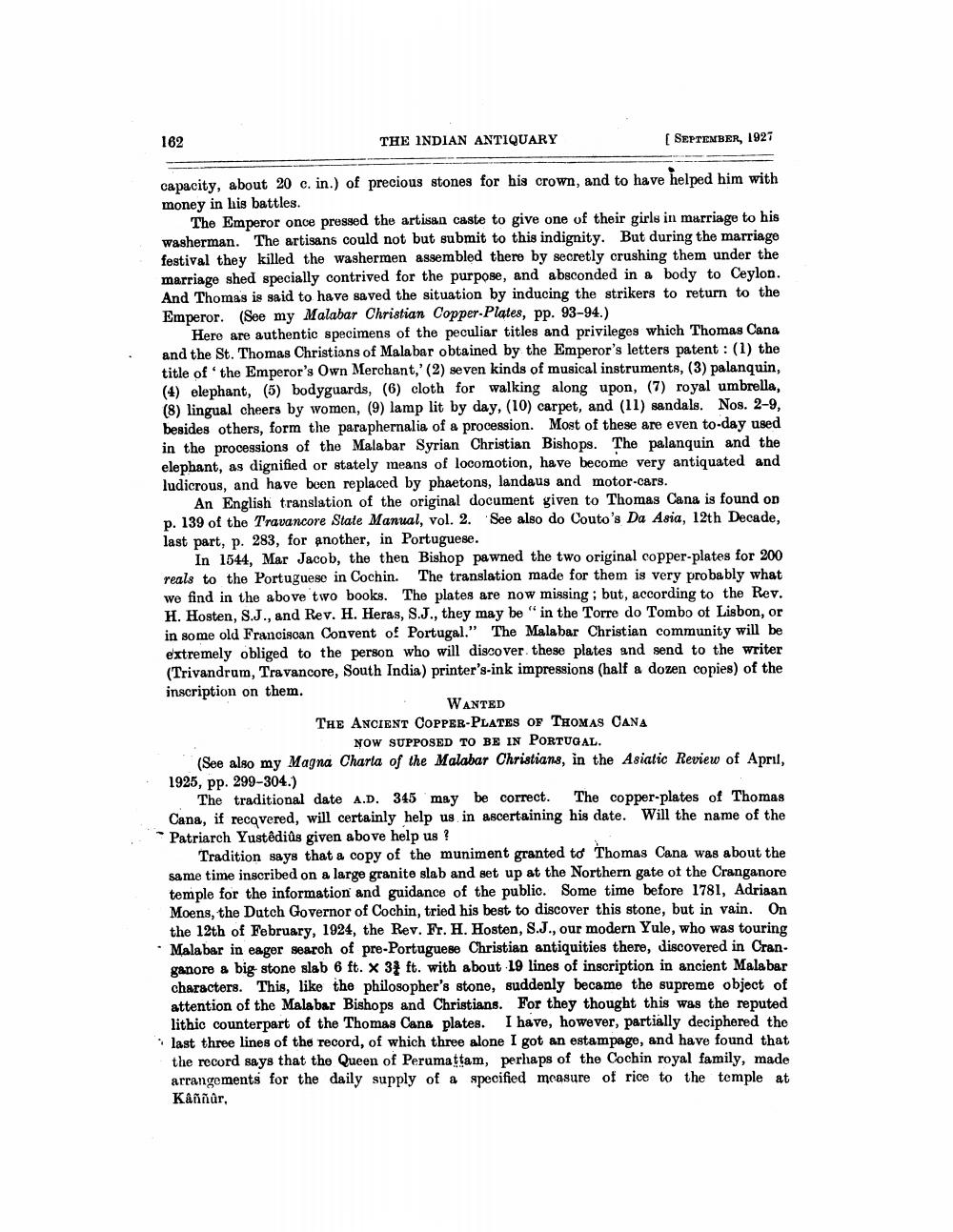________________
162
THE INDIAN ANTIQUARY
[ SEPTEMBER, 1927
capacity, about 20 с. in.) of precious stones for his crown, and to have helped him with money in his battles.
The Emperor once pressed the artisan caste to give one of their girls in marriage to his washerman. The artisans could not but submit to this indignity. But during the marriage festival they killed the washermen assembled there by secretly crushing them under the marriage shed specially contrived for the purpose, and absconded in a body to Ceylon. And Thomas is said to have saved the situation by inducing the strikers to return to the Emperor. (See my Malabar Christian Copper-Plates, pp. 93-94.)
Here are authentic specimens of the peculiar titles and privileges which Thomas Cana and the St. Thomas Christians of Malabar obtained by the Emperor's letters patent : (1) the title of the Emperor's Own Merchant,'(2) seven kinds of musical instruments, (3) palanquin, (4) elephant, (5) bodyguards, (6) cloth for walking along upon, (7) royal umbrella, (8) lingual cheers by womon, (9) lamp lit by day, (10) carpet, and (11) sandals. Nos. 2-9, besides others, form the paraphernalia of a procession. Most of these are even to-day used in the processions of the Malabar Syrian Christian Bishops. The palanquin and the elephant, as dignified or stately means of locomotion, have become very antiquated and ludicrous, and have been replaced by phaetons, landaus and motor-cars.
An English translation of the original document given to Thomas Cana is found on p. 139 of the Travancore State Manual, vol. 2. See also do Couto's Da Asia, 12th Decade, last part, p. 283, for another, in Portuguese.
In 1544, Mar Jacob, the then Bishop pawned the two original copper-plates for 200 reals to the Portuguese in Cochin. The translation made for them is very probably what we find in the above two books. The plates are now missing ; but, according to the Rev. H. Hosten, S.J., and Rev. H. Heras, S.J., they may be " in the Torre do Tombo of Lisbon, or in some old Franciscan Convent of Portugal." The Malabar Christian community will be extremely obliged to the person who will discover these plates and send to the writer (Trivandrum, Travancore, South India) printer's-ink impressions (half a dozen copies) of the inscription on them.
WANTED THE ANCIENT COPPER-PLATES OF THOMAS CANA
NOW SUPPOSED TO BE IN PORTUGAL. (See also my Magna Charla of the Malabar Christians, in the Asiatic Review of April, 1925, pp. 299-304.)
The traditional date A.D. 345 may be correct. The copper-plates of Thomas Cana, if recqvered, will certainly help us in ascertaining his date. Will the name of the Patriarch Yustêdiùs given above help us ?
Tradition says that a copy of the muniment granted to Thomas Cana was about the same time inscribed on a large granite slab and set up at the Northern gate of the Cranganore temple for the information and guidance of the public. Some time before 1781, Adriaan Moens, the Dutch Governor of Cochin, tried his best to discover this stone, but in vain. On the 12th of February, 1924, the Rev. Fr. H. Hosten, S.J., our modern Yule, who was touring Malabar in eager search of pre-Portuguese Christian antiquities there, discovered in Cranganore a big stone slab 6 ft. X 31 ft. with about 19 lines of inscription in ancient Malabar characters. This, like the philosopher's stone, suddenly became the supreme object of attention of the Malabar Bishops and Christians. For they thought this was the reputed lithic counterpart of the Thomas Cans plates. I have, however, partially deciphered the last three lines of the record, of which three alone I got an estampage, and have found that the record says that the Queen of Perumattam, perhaps of the Cochin royal family, made arrangements for the daily supply of a specified measure of rice to the temple at Kaññûr,




